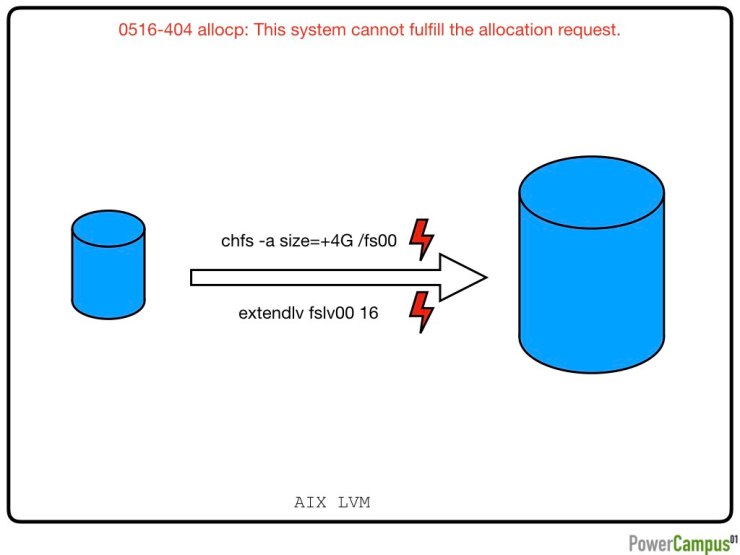The individual phases of an I/O in a FC-SAN are shown. Then the model is simplified to have only 3 phases. The actual length of time for each phase is shown in a diagram for some FC technologies. The round trip time turns out to be decisive for the duration of an I/O. Based on this, the maximum possible throughput of an individual single I/O is determined and shown graphically for various I/O sizes depending on the round-trip time.
When increasing logical volumes or file systems, the error “0516-404 allocp: This system cannot fulfill the allocation request” often occurs. Many AIX administrators are then a little at a loss as to what the cause of the problem is: is it max LPs or upper bound, the chosen strictness, or does the problem have completely different causes. Unfortunately, the error message is only generic and does not say what the real problem is. A good way to get to the cause of the problem is the alog lvmt, in which all LVM actions, especially the low-level commands, including error messages are logged. The following is a series of examples which show how useful this log is to find the cause of the problem quickly in many cases.
With the AIX LVM migratepv command, physical volumes can be exchanged in mirror copies of logical volumes. We want to take a closer look at how the migratepv command works in detail. Using a few examples, the cases of unmirrored logical volume, mirrored logical volume (2 copies) and mirrored logical volume (3 copies) are shown.
The AIX LVM command migratepv can be used to exchange physical volumes in mirror copies of logical volumes. In the second part we want to take a closer look at how the migratepv command works in the case of mirrored logical volumes with 3 copies.
The AIX LVM command migratepv can be used to exchange physical volumes in mirror copies of logical volumes. The third part is about the correction of “wrong” mirroring. The possibilities that arise are discussed. The possibilities shown are demonstrated using a larger example from practice.
With the AIX LVM migratelp command, individual physical partitions can be replaced in a logical volume. The article will take a closer look at how the migratelp command works.
Under AIX, it is easy to build installp packages yourself. For this there is the command mkinstallp under AIX. We show a simple example using mkinstallp. More complex packages will be covered in a later article.
Almost all today’s programs under AIX are dynamically linked, i.e. necessary libraries are loaded and bound at runtime (run-time linking). But how does a program know which libraries are needed and in which directory they can be found? What can you do if a library is not found automatically? What is the meaning of the variables LIBPATH and LD_LIBRARY_PATH?
The article describes the necessary steps to run Inventory Scout automatically on a number of systems. Then a script is shown (download available) that conveniently implements these steps. Finally, the collection of microcode levels on any number of systems is possible with a single call of the script.
Many IT environments operate their systems in more than one data center. In order not to have any data loss in the event of a failure of an entire data center, the data is mirrored between 2 or more data centers. The mirroring can be realized by the storage (storage based mirroring) or by a volume manager (LVM in the case of AIX) on the server (host based mirroring). In the following we only consider mirroring using the AIX Logical Volume Manager. The aim is to show how the correct mirroring of logical volumes can be implemented with the help of mirror pools. In larger environments with many physical volumes, maintaining correct mirroring without mirror pools is difficult and a challenge for the administrator.
The use of mirror pools simplifies the correct mirroring of logical volumes between physical volumes from different data centers. For the greatest possible redundancy and failure safety, care should be taken when mirroring, that all physical volumes of a mirror copy come from the same data center. This can be achieved very easily with mirror pools. In the following, the meaning of the mirror pool strictness will be examined in more detail; it can be set to one of the values ‘n‘ (no), ‘y‘ (yes) or ‘s‘ (super-strict) for each volume group.











You must be logged in to post a comment.